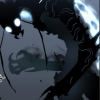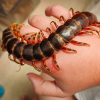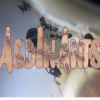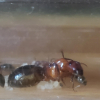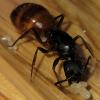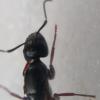Hello ColAnt735;
Unfortunately, I don't have any experience with Solenopsis molesta, but I can tell you what I've learned from the large colonies I do have.
As some of my colonies get larger, they seem to have a change in attitude from shy, retiring workers afraid to come into the daylight, to frantic hordes determined to escape no matter what the cost. Because of this I've had to institute a "no escape - no return" policy with my ants. My formicaria must be escape proof and no wayward ant is ever returned, (believe me, my wife insists on these conditions). I have only developed foolproof escape barriers for Camponotus and Tapinoma ants (using mineral oil and talcum powder), so they're the only two types I keep in open top containers. All the rest of my colonies are kept in containers that have tight fitting lids and stainless-steel screens over holes for ventilation. This becomes important as the larger a colony becomes, the more persistent and determined they become. Last year I had two similar sized Tetramorium colonies. In each setup I had used a cork to plug an access tube that wasn't being used. After two years both colonies chewed through their cork within a day of each other. There can be very large numbers of very determined ants. With larger colonies, escape must be as impossible as you can make it. They will put debris on Vaseline until they've made a bridge they can walk over; they'll try to get over talcum powder barriers relentlessly until they've worn it away and can finally climb out. They'll skate over Fluon and they'll chew on screens and glue or anything else that might afford the chance for escape. This means that as colonies grow larger, reapplication of barriers and regular inspections become more important to stop escapes before they happen.
Outworlds can be added or improved to provide "entertainment" value and reduce ant boredom. I feel the larger a colony gets, the more they appreciate a naturalistic setup in their outworld. At least an outworld that takes advantage of the three-dimensional space available, instead of just a sandy floor with a couple of rocks. I try to outfit one outworld with large rocks, hollow branches, some soil, plastic plants and flowers, a wet hole or oasis, moss - anything for them to dig and play in - sort of a playground outworld. If it's too busy to feed there, I attach a smaller outworld where I do the feeding and watering of the colony. It has a lid which I remove for feeding and there's a barrier to prevent escapes during feeding, or I use a feeding port.
Larger colonies need to be fed more frequently. I try to feed my large colonies six days a week with a fasting day on the seventh. This lets them clean up any stored food in the nest, although I usually try to feed them enough to only last one day. The larger a colony gets the more food they will require and the more trash they'll produce. To reduce this problem, I feed larger colonies mostly meat products that are a lot easier to cut up and feed than insects and meats produce little trash. Larger colonies don't seem to be quite as picky about food as smaller ones. One of the joys of a large colony is watching them swarm a food item, dismantle it and transport it back to the colony. A small piece of chicken replaces many flies and crickets, so you don't have to keep or buy large numbers of feeder insects, avoiding those odor issues. Less trash means fewer odors too.
As a colony gets larger its' requirement for water and sugar/water also increases, making filling feeders more frequent and difficult. I usually switch my larger colonies to test tubes with cotton plugs for both sugar/water and water. I either place them in an outworld or attach them to tubing where they are easily replaced when empty.
Every environment has limitations to its' carrying capacity and population control is often the only alternative to maintain a balance (I fear the human race will discover this too late). Culling or selective removal of ants mimics the effect of predators and other natural controls that keep an ant population in check. To reduce the negative impact on the colony I try to remove an equal number of older foraging workers before a new batch of workers ecloses. I find that a small number of ants removed regularly is easier for a colony to maintain than removal of a large number of ants all at once.
Hello Futurebird;
Try using "heavy mineral oil" as a barrier in your outworlds. It's available at your pharmacy. I use it as a barrier for all my ants and so far, only Lasius americanus and Temnothorax ants have been able to easily cross it. Most of my ants stop dead when they reach it. I use a cotton swab to apply it in a narrow strip around the area I don't want the ants to cross. I put it around screens and feeding ports to keep ants out, but here's a little tip. Don't put it at the top of the walls you don't want them to climb. Put it all around the bottom of the walls. I find that a 1/4-to-1/2-inch (1-2 cm) strip is all it takes. I started doing this because mineral oil is thin (even the heavy oil) and it will run if I put it at the top. Putting it at the bottom eliminates that problem with the added bonus that any adventurous ant that does cross it will have nicely oiled "feet" and will find it impossible to climb up the smooth acrylic wall. Often, they just stop trying. And if they're real escape artists you can add a second barrier at the top. Talcum powder sticks really well to oily feet and they fall off every time.
RPT
My father always said I had ants in my pants.


